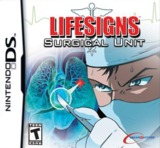It's too bad that Dreamcatcher can't even copy games correctly...
Lifesigns: Surgical Unit can be divided into two different parts: surgery and adventure modes. I'll start with the surgery mode. The first, and probably the most disheartening, problem the game has to offer is the extreme level of difficulty. It's not so much that the game is really hard, it's just that there is basically no tutorial and no guidance during the surgeries. While Trauma Center offers plenty of guidance while doing the surgeries, Lifesigns basically just expects that you know how to perform them already. I suppose if you are in med school or a real doctor, you won't have a problem with lifesigns but if you don't fall under either of those categories, you won't have any clue what to do. Fortunately, when the main character Tendo "concentrates" he can see a general idea of what he's supposed to do. The problem with this is that, not only does it waste valuable time, it takes up some of the patients health to use. The only good thing about this skill is that you can use it as many times as you want (as long as your patient isn't dead). If the surgery was all you did throughout the game, it would be impossibly difficult but fortunately they have...
An adventure mode! This is where you can clearly see Phoenix Wright influence. You must wander around the hospital talking to people and showing them various medical notes and whatnot that help further the storyline along. Unfortunately, anything good about these portions of Phoenix Wright was ripped out, thrown on the ground and stomped on so that only the awful, repetitive boredom remains. The reason that these portions are entertaining in Phoenix Wright is because of two things, the storyline is actually interesting in PW, and because you actually feel like you are accomplishing something. Neither is present in Lifesigns. There is no obvious plotline and each mini case is just as boring as every other one. It's always extremely obvious where you're supposed to go next and what you are supposed to show each and every person. Normally, this would seem like something just thrown in the game to get you from surgery to surgery but no. You will spend the vast majority of your gameplay, going around talking to people like this, desperately trying to get to the next surgery portion as fast as possible. Then you remember just how horrible the surgery is and fall into this desperate cycle.
"But the storyline! It's got a classic anime storyline, right katosepe? So since i'm an anime fan, it'll be fun for me, right?" Wrong. I'm personally an anime fan and can stand even the cheeziest storylines. But this really isn't even an issue for lifesigns since theirs no storyline to stand. The characters aren't interesting at all and stay completely static throughout the game. In fact, some of the secondary characters are more interesting than the main ones. At least they have some personal problem to get fixed. Half the time, you'll rather listen to the patients than the doctors. Oh sorry, did I say listen? I meant read, since there is absolutely no spoken dialogue at all. Although this is probably a blessing considering the quality of the rest of the game. On the other hand, maybe if we had voice-overs, we wouldn't have to suffer through horrible translations and obvious typo's practically slapping us across the face over and over again.
In the end, you look to the music for comfort, trying to find relief by tuning into the gentle song. Except that then you realize that the screechy, annoying, repetitive music is almost as bad as everything else. I say "almost" since if it was as bad, I don't think it would be considered music.
You're probably thinking at this point, wow, he really hates this game. How much more can there possibly be? Well, there's one thing to the game's benefit. It's long. Although considering how horribly painful this game is, length will only extend the torture. But don't worry, I have found a cure for this pain we call Lifesigns: Surgical Units. It's called a trashcan.

